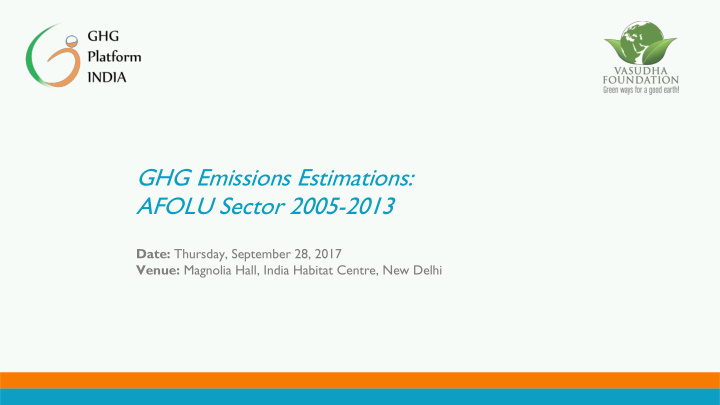



Title of the Presentation GHG Emissions Estimations: AFOLU Sector 2005-2013 Date: Thursday, September 28, 2017 Date Venue: Magnolia Hall, India Habitat Centre, New Delhi Venue
GHG Emissions Estimates from AFOLU Heading 3A Livestiock Aggregate Sources and 3B Land Non-CO2 emissions • 3A1 Enteric Fermentation • 3B1 Forest Land sources on Land • Manure Management • 3B2 Cropland Bullet Points • 3C1Biomass burning • 3B3 Grassland • 3C4 Direct N2O emissions • 3B4 Wetlands from managed soils • 3B5 Settlements • 3C5 Indirect N2O • 3B6 Other land emissions from managed soils • 3C7 Rice cultivation
Trends of Emissions CO2e from AFOLU sector (2005-13) 300 250 230.27 228.94 226.57 227.61 226.28 224.95 222.87 223.62 223.13 200 Emissions (tCO2e) millions 150 128.13 126.55 125.76 123.56 123.43 120.22 120.76 117.78 112.40 100 50 0 2005 2006 2007 2008 2009 2010 2011 2012 2013 -50 -100 -150 -134.03 -134.03 -134.03 -135.91 -135.91 -135.91 -177.73 -177.73 -177.73 -200 Livestock Land Aggregate Sources and Non-CO2 emissions sources on land Total
2005 2013
Share of emissions in AFOLU sector from top five states in India (in 2013) 15% 31% Uttar Pradesh 9% Rajasthan Andhra Pradesh Bihar Maharashtra 14% Rest of India 15% 16%
Category wise share of emissions from AFOLU sector excluding Forest Land (2005 to 2013) 100% 6% 6% 6% 6% 6% 6% 6% 6% 6% 90% 80% 70% 59% 58% 58% 60% 59% 59% 60% 59% 58% 60% 50% 40% 30% 20% 20% 20% 20% 21% 20% 21% 21% 20% 20% 10% 14% 15% 15% 15% 13% 13% 12% 12% 11% 0% 2005 2006 2007 2008 2009 2010 2011 2012 2013 Agriculture Soils Biomass Burning in Cropland Biomass Burning in Forest Land Rice Cultivation Cropland Grassland Other Land Settlements Enteric Fermentation Manure Management
Category wise share of emissions from Livestock Sector (2005-13) 120% 1% 1% 1% 1% 1% 100% 1% 1% 1% 1% 10% 10% 10% 10% 10% 10% 10% 10% 10% 80% 40% 42% 40% 45% 44% 43% 46% 45% 45% 60% 40% 50% 49% 48% 48% 47% 46% 46% 45% 44% 20% 0% 2005 2006 2007 2008 2009 2010 2011 2012 2013 Bovines Dairy Bovines Non Dairy Sheep and Goat Others
Mitigation Opportunities from Livestock Sector • The three major strategies for pursuing mitigation from bovines are: • Dietary manipulation , through supplementing of green fodder intake and/or concentrated feeding. • Feed additives , primarily Monensin • Strategic feed supplementation, through adding Urea Molasses Mineral Block to cattle feeds. • At the lower end of the range of their mitigation potential, these strategies could reduce emissions from bovines by 25% or overall by 20% from enteric fermentation as a whole
Mitigation Opportunities in Rice Cultivation Area Under Rice Emission factors for Total Emissions Cultivation (million various rice ecosystems Estimates from rice hectares) (kg per hectare, cultivation (million methane) tonnes CO2 equivalent) Continuous Flooding 6.86 162 22.05 (irrigated) Single Aeration (irrigated) 9.11 66 11.77 Multiple Aeration 9.54 18 4.00 (irrigated) Rain fed/ flood prone 3.17 190 14.42 (unirrigated) Rain fed/ drought prone 8.54 66 12.23 (unirrigated) Deepwater 1.31 190 4.98 Upland (unirrigated) 5.26 0 0 Total 43.79 69.43
Negative Emissions From Forest Land
Emissions from Land Excluding Forests
Thank You!! www.ghgplatform-india.org @GHGPlatform_Ind @GHGPlatformIndia
Recommend
More recommend